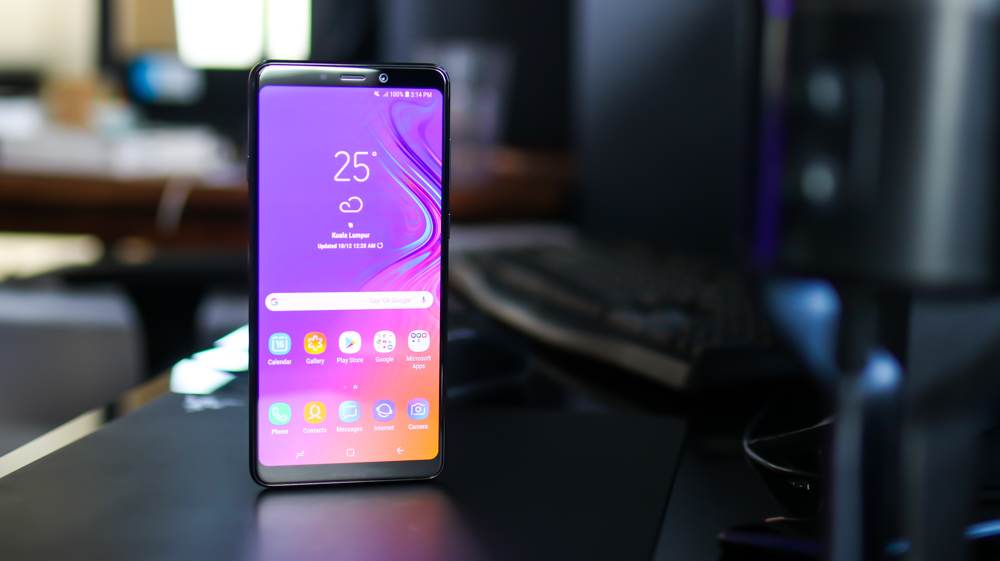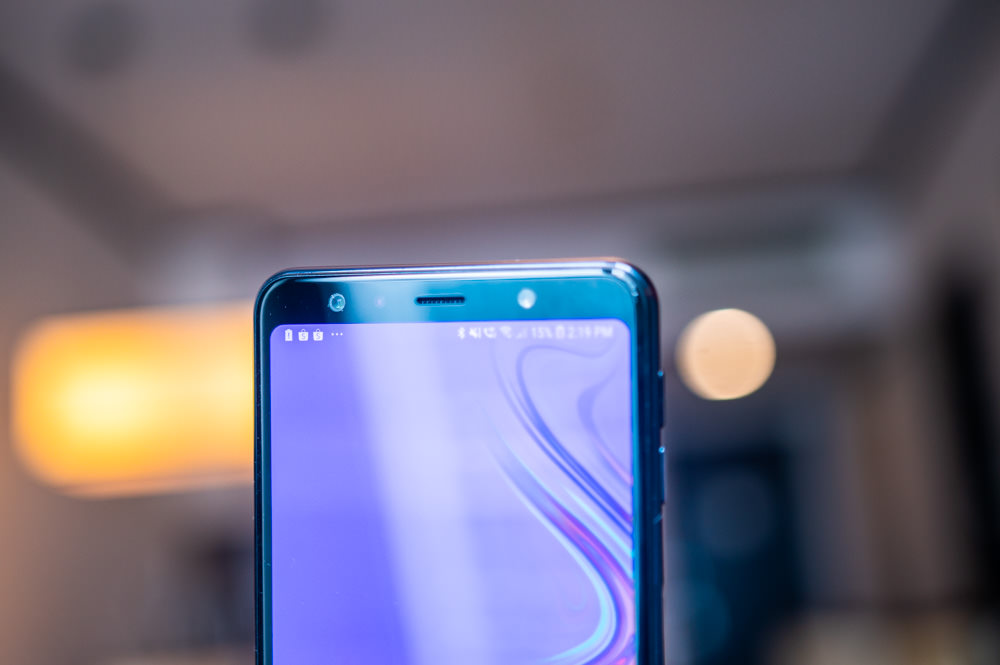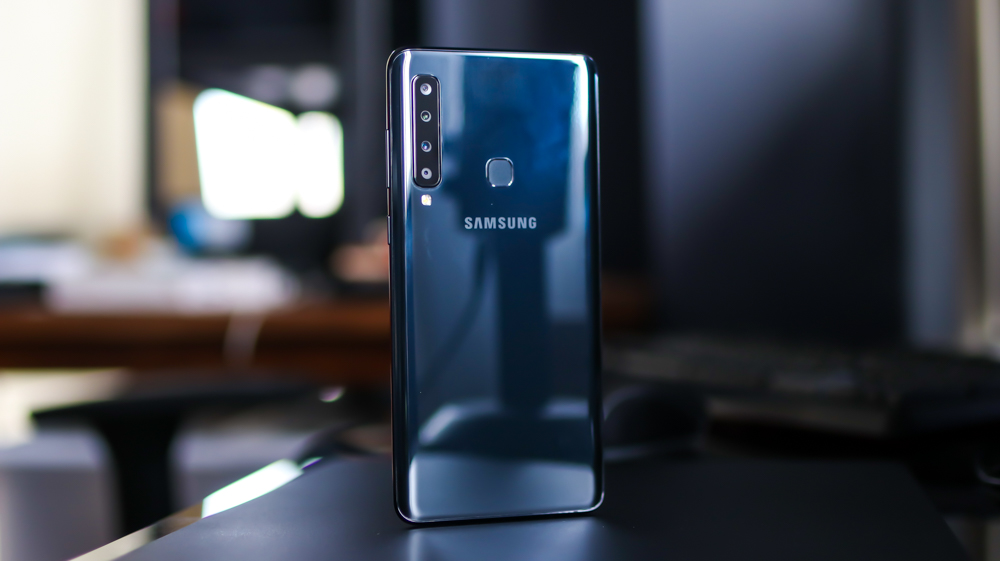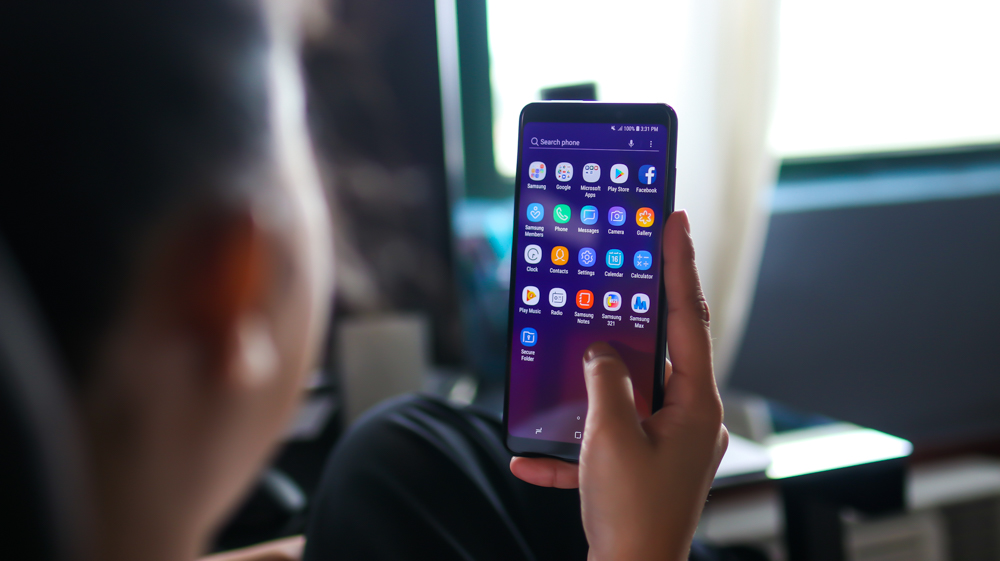In October, Samsung released a new premium mid-range smartphone that features a 6.3-inch screen, a Snapdragon 660 octa-core chipset, and four rear cameras, the Galaxy A9 (2018). The camera setup suggests that this phone is for photography. But considering all its features, price, and competition, is this phone worth getting? Let’s find out in our review.

Table of Contents
Despite the new specs and features, the looks of the Galaxy A9 (2018) hasn’t changed a lot especially if you compare it to other Galaxy A series devices in the past. It even looks like the Galaxy A8 (2018), but wider, so some might consider it as dull.

It has a 6.3-inch display with 2.5D glass. Above it are earpiece, sensors, and 24MP selfie camera. It has a slim top and bottom bezels given the 18.5:9 aspect ratio.

Up top are the microphone and triple card tray for two nano-sized SIM cards and a microSD card. Down below are the 3.5mm audio jack, USB-C port, and loudspeaker.

On the left, we have the dedicated Bixby button, while on the right are the volume and power/lock buttons. They’re clicky, feels sturdy, and reachable but can be quite a stretch if you have small hands.

Flip it on its back, and you will see the star of the show which is the quad-camera setup lined up on the left side, the LED flash, and the fingerprint scanner at the center.

Although it looks similar to other A-series devices, the A9 (2018) is still a good-looking device especially if you consider the Lemonade Blue color. What we have here is the Caviar Black model which is not bad. However, we’re sad to learn that this doesn’t have any IP rating like the Galaxy A8+ (2018).

It’s premium and has a decent heft to it, thanks to the metal frame and glass front and back. The glass back curves to sides for that more ergonomic feel but as expected, it’s a fingerprint and smudge magnet. Again, it is tall given the large screen so navigating it with one hand can be a challenge.
If you like to watch videos or play games, the A9 (2018) won’t disappoint. At 6.3-inch, it has the size for a more immersive viewing experience. The Full HD+ (2220 x 1080) resolution equates to a pixel density of 392ppi which is still sharp. Lastly, it has a Super AMOLED panel, so the screen is vibrant with rich colors and good contrast.

Also, you can tweak the display by choosing from different screen modes. You can also adjust the color balance as well as the individual RGB color.

When it comes to audio, there’s no dual-speaker setup, and the bass is weak, but the lone down-firing speaker is loud and crisp enough for casual use like watching videos on YouTube and Netflix and listening to some songs on Spotify. If you use a headphone, you can activate Dolby Atmos and tweak the audio quality using the equalizer, UHQ Upscaler, Tube Amp Pro, or Concert hall.
The Galaxy A9 (2018) boasts as the world’s first quad camera smartphone. The four cameras at the back are all different and offer different shooting experiences. Starting from the top, we have the 8MP F2.4 ultra wide camera with 120-degree FOV, then the 10MP F2.4 telephoto with 2x optical zoom, then the 24MP F1.7 main camera, and the 5MP F2.2 depth camera for Live Focus.

It seems impressive as it allows the A9 (2018) to adapt to various shooting conditions: the wide-angle camera for landscapes and group shots, the telephoto if you want to get up close, and the main camera for general shooting and low-light scenarios. The depth camera, on the other hand, is just there to assist the main camera for Live Focus feature. You can easily switch between cameras with an on-screen toggle, which we find difficult to operate when shooting with one hand.

Live Focus is a cool feature that allows you to shoot a subject then adjust the focus later. It also provides a cool bokeh effect as long as there’s a reasonable distance between the subject and the background. As for other features, the Galaxy A9 (2018) has the Scene Optimizer which adjusts the color settings of the photo based on the scene, Super Slow-Mo, AR Emoji, Hyperlapse, Beauty, Pro, and Panorama.

When it comes to quality, the cameras perform well in bright conditions, but you’ll notice differences in quality since they’re using different sensors. The 24MP main camera works the best in most situations as photos are sharp with accurate colors. The 8MP wide-angle does the job in capturing most of the scene although not as detailed and looks smudgy up close, while the 10MP telephoto sits between the two but still sharp with clean details. Low-light performance though is not good and gets peppered with noise while details get smudgy, especially when using the wide-angle camera.
Selfies, on the other hand, are underwhelming. Details are too soft and lack sharpness even in bright conditions and get worse in low-light. For a 24MP sensor, this is disappointing.
When it comes to videos, it can record up to 4K resolution at 30fps. At this resolution, it can’t use HDR, video effects, and video stabilization. If you want the mentioned features, you’ll have to scale down to 1080p. Otherwise, the result is video that is prone to shakes like the one below.
Running the Galaxy A9 (2018)’s software is Android 8.0.0 Oreo with Samsung Experience 9.0. It’s a little outdated compared to the 8.1 Oreo with SE 9.5 that the Galaxy Note9 has, but the experience is pretty much the same.

The UI uses an app drawer that is accessed by swiping your finger upwards from the home screen. It has your usual Google Apps, as well as a few from Microsoft, and Samsung. Upon first boot, these apps will ask for an update so that can take a while before it finishes, especially if you have a slow connection.

Storage-wise, we’re getting 109GB of usable space out of the 128GB, which is still sizeable. If you’re planning to expand it, we’re glad to report that it has a dedicated microSD card slot so, you don’t lose the dual-SIM functionality.
Performance and Benchmarks
Powering the Galaxy A9 (2018) is a Snapdragon 660 octa-core processor, with Adreno 512 GPU and 6GB RAM. This Snapdragon 660 is a high-end chipset that sits just below the new SD675/670. We didn’t encounter any problem with its performance as UI navigation is fast, the fingerprint scanner and face recognition are very responsive and quick, apps launch fast, while multitasking is smooth.

It also has a gaming feature called Game Launcher which optimizes your phone for best performance when gaming, and Game Tool which manages your notifications for to minimize distractions as well as PIP mode if you need to check on messages real quick.

Gaming is not an issue and can run PUBG Mobile in HD graphics, High frame rate, with anti-aliasing on. Thermals are good with just some slight warming at the back near the fingerprint scanner. For the benchmarks, check them out below:
• AnTuTu – 136,899
• Geekbench 4 – 1,421 (Single-Core), 5,318 (Multi-Core), 5,470 (RenderScript)
• 3DMark – 1,340 (SSE – OpenGL ES 3.1), 1,063 (SSE – Vulkan)
• PCMark – 5,995 (Work 2.0)
• AndroBench – 290.24 MB/s (Read), 178.56 MB/s (Write)
Connectivity is not a problem as it has everything including dual-SIM with 4G, dual-band WiFi, Bluetooth 5.0, and GPS. Calls are loud and clear, mobile data is fast, and GPS locks in quick in apps like Google Maps, Waze, or Grab.

Battery-wise, the Galaxy A9 (2018) has a 3,800mAh battery with fast charge. It’s a good battery capacity, but it would have been more attractive if they stretched it to 4,000mAh given its size. Still, we were able to get good mileage on it, getting around 10 to 12 hours a day of mixed usage. PC Mark rated it at 9 hours and 38 minutes while our video loop test got us 26 hours of playback which is impressive
The Galaxy A9 (2018) is a device aimed at multimedia-heavy users who like taking photos and consume online content on a big screen. It’s also a good device for gaming as it has a good hardware configuration and a big battery. However, as a photography-centric device, as suggested by its four cameras, it failed to impress.

And then there’s the price. At PHP 32,990USD 562INR 47,657EUR 535CNY 4,094 that’s pretty steep for a mid-ranger, considering that there are other smartphones in the market in the same price range but with better chipsets and cameras. Don’t get me wrong, the A9 (2018) is a great daily driver, but if you want a smartphone for photography, I suggest looking somewhere else.
Samsung Galaxy A9 (2018) specs:
6.3-inch FHD+ (2220 x 1080) Super AMOLED display, 18.5:9, 392ppi
Qualcomm Snapdragon 660 2.2GHz octa-core CPU
Adreno 512 GPU
6GB RAM
128GB storage
microSD up to 512GB (dedicated slot)
Rear cameras:
• 24MP AF, F1.7 main
• 10MP AF, F2.4, 2X optical zoom telephoto
• 8MP, F2.4, 120° ultra wide
• 5MP, F2.2 depth
24MP F2.0 front camera
Dual-SIM
4G LTE
WiFi 802.11 a/b/g/n/ac
VHT80 MIMO
Bluetooth 5.0 LE, ANT+
NFC
GPS, A-GPS, GLONASS, Galileo, Beidou
USB Type-C
Fingerprint scanner
3.5mm audio jack
Android 8.0 Oreo
3,800mAh battery w/ fast charge
162.5 x 77 x 7.8 mm
183g
What we liked:
• Good build
• Large screen with good quality
• Good performance
• Dedicated microSD card slot
• Four rear cameras for versatile shooting
• Large battery
What we didn’t:
• Underwhelming cameras
• No water and dust resistance
• Pricey for a mid-range

YugaTech.com is the largest and longest-running technology site in the Philippines. Originally established in October 2002, the site was transformed into a full-fledged technology platform in 2005.
How to transfer, withdraw money from PayPal to GCash
Prices of Starlink satellite in the Philippines
Install Google GBox to Huawei smartphones
Pag-IBIG MP2 online application
How to check PhilHealth contributions online
How to find your SIM card serial number
Globe, PLDT, Converge, Sky: Unli fiber internet plans compared
10 biggest games in the Google Play Store
LTO periodic medical exam for 10-year licenses
Netflix codes to unlock hidden TV shows, movies
Apple, Asus, Cherry Mobile, Huawei, LG, Nokia, Oppo, Samsung, Sony, Vivo, Xiaomi, Lenovo, Infinix Mobile, Pocophone, Honor, iPhone, OnePlus, Tecno, Realme, HTC, Gionee, Kata, IQ00, Redmi, Razer, CloudFone, Motorola, Panasonic, TCL, Wiko
Best Android smartphones between PHP 20,000 - 25,000
Smartphones under PHP 10,000 in the Philippines
Smartphones under PHP 12K Philippines
Best smartphones for kids under PHP 7,000
Smartphones under PHP 15,000 in the Philippines
Best Android smartphones between PHP 15,000 - 20,000
Smartphones under PHP 20,000 in the Philippines
Most affordable 5G phones in the Philippines under PHP 20K
5G smartphones in the Philippines under PHP 16K
Smartphone pricelist Philippines 2024
Smartphone pricelist Philippines 2023
Smartphone pricelist Philippines 2022
Smartphone pricelist Philippines 2021
Smartphone pricelist Philippines 2020
Samsungverybadmarketing says:
4 cheap cameras + sd 660 for P33k? Kaya pala phase out na ang galaxy s8 dahil sure flop ang a9 2018 sa s8.
SougGaming says:
Wow.. 32k then SD660 lang. I’ll go with Oneplus 6/6T then. Sure na sulit pa.